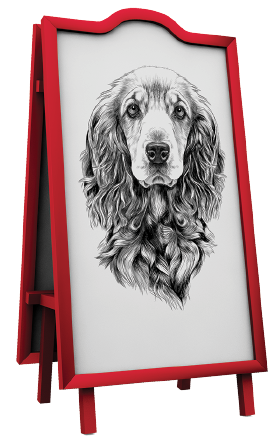NO SELF-RESPECTING STORY on modern marketing starts without a few staggering statistics. Here are some to ponder:
- Prior to the availability of smartphones, American consumers accessed the Internet an average of five times a day. Now, one in four Americans reports being online constantly.
- Forty years ago, we were exposed to about 500 commercial messages a day. Today it’s 5,000, possibly 10,000 if you live in a big urban area and use the internet a lot.
- A typical grocery shopper spends 21 minutes doing her shopping, during which she buys an average of 18 items out of the 30,000 to 40,000 choices available to her, all while being bombarded by sale signs, commercial jingles, and other moving displays and psychologically tested packaging.
 If you’re now feeling like a tiny entity that’s lost its voice after shouting to be heard in a noisy marketplace, you shouldn’t. There’s actually never been a better time to be a small-business owner, at least when it comes to marketing.
If you’re now feeling like a tiny entity that’s lost its voice after shouting to be heard in a noisy marketplace, you shouldn’t. There’s actually never been a better time to be a small-business owner, at least when it comes to marketing.
Through social media and the ultra-connectedness of consumers, small businesses can foster personal customer relationships that are the envy of bigger companies. It is also easier than ever to leverage your distinctive personality — read: “brand” — to separate yourself from the competition.
And in a world saturated with information, consumers are increasingly turning a deaf ear to the appeals of corporate marketers. Instead, they are putting their faith in the opinions of their fellow shoppers. Word of mouth is the new mass media.
For all the things that change, there are others that stay the same, and in retail, the one great constant is that consumers are powered by emotion.
To help you make the right choice for your business, and in the spirit of our distracted age, we’ve distilled the benefits of the various marketing mediums to just one thing. So, turn off your phone, power down your iPad and focus for the next few minutes.
1. Branding
The one thing to know: As the owner of a retail business, it pays to be accessible (meaning spending time on the sales floor), to be a little larger than life, to be a genuine persona that can be carried through to every part of your marketing. The unique human element is one of the advantages small businesses have over corporations. Discover your uniqueness and parade it around your sales territory. Forget about being benign and fitting in. Forget about saying, How can we help you? Focus on sharing stories and building relationships, says Peter Montoya in A Brand Called You.
One thing to do now: Add some “campfire language” to your website’s About Us page. Most introductory pages are drearily formulaic, telling the buying public what you do but not who you are. Yet in most cases, what you do or offer in the way of services is little different than what the five other pet businesses in your area provide. In contrast, no one else has your story. Share it and start to build emotional connections with the people in your market. In place of those claims to be the best at one thing or another, offer some insights into how you feel about pets, your ties to the community and your non-work interests.

2. Newspapers
The one thing to know: Traditional wisdom said: Advertise in the newspaper. Everyone reads the newspaper. Conventional wisdom says: Newspaper readers are aging rapidly as the young abandon print. We say: Don’t buy too much into it. If you need to raise awareness of a sale, a relocation or another event, newspaper ads (run frequently before the big day) can still deliver your message. Don’t forget to run a photo.
One thing to do now: Newspapers are willing to bargain more than ever before. Ask for a free banner ad on your local paper’s website when you buy a print ad. That way, you get some insurance that younger readers will be reached while you get to experiment with online advertising.
3. Outdoor
The one thing to know: Billboards reach more people for a dollar than any other media, and they’re geographically targetable, so you can reach specific pockets of your market with them. Their weakness is that they fail to register with regular passing drivers after just a few sightings in the same location, so you need to be able to update the message or move your ad after about a month or so.
One thing to do now: Put more than eight words on a sign, and you’ll be advertising to the passenger seat. Can’t tell your story in eight words? Think again. The image should be telling most of the story anyway. (Oh, and don’t forget your contact info.)
4. Direct Mail
The one thing to know: It’s expensive, and most of it is tossed out. Use it mainly to stay in touch with your best customers.
One thing to do now: A service from the U.S. Post Office — Every Door Direct — allows you to leverage direct mail’s biggest strength, the ability to target geographically, at a reasonable price. The terms: Minimum of 200 standard flat-mail pieces (under 3.3 ounces) to be delivered via a “saturation mailing” to a particular postal route (meaning every household on that route will get your mailer, at a rate of just 14.5 cents per piece.).
5. Marketing
The one thing to know: Those 5,000 other commercial impressions you’re battling with every day? Wit will help you cut through the noise. Examples of guerrilla marketing include Colgate inserting toothbrush-shaped sticks in ice cream with a reminder: “Don’t forget to brush;” the Fitness First health chain setting up a set of scales under a bus stop seat and an accompanying digital sign displaying to all how much the person weighed; and Absolut Vodka sticking what appeared to be plundered boxes of vodka that went round and round on airport baggage carousels. The rise of social media and the chance to get potentially millions of views on YouTube has added to the impact of such stunts.
One thing to do now: While guerrilla marketing has been embraced by big companies (think Red Bull’s outer-atmosphere parachute jump), it has its origins in smaller businesses seeking to generate a buzz on a tight budget. What could you do that’s out of this world … or at least outrageous?
6. Promotions
The one thing to know: Be bold or be ignored. Promotions remain the best way to quickly build excitement and attract people to your store. But … price-driven events don’t keep you top of mind throughout the year. And you run the risk of training your market to wait for discounts.
One thing to do now: Involve your staff in the planning of any sale or promotion. Be clear in your planning on exactly what it is you’re trying to achieve: Do you want to raise cash or promote a brand? Get rid of old merchandise or have an event?

7. Gift Certificates
The one thing to know: The most powerful gift certificates are those that have no minimum purchase requirements. If you’ve got the nerve to do it, offer $25 and watch your customers pour in.
One thing to do now: Are there employers like insurers, banks, hospitals or car dealerships in your area? In the months before the holiday season, approach management with an offer to provide customized gift certificates that could be distributed with payroll checks prior to the Thanksgiving holiday. It will make the bosses, and your sales, look good.
8. Website
The one thing to know: If you don’t have a decent, mobile-friendly website, you do not exist. Marketing tool, e-commerce platform, store catalog, social media portal, first impressions … it’s difficult to overstate how important your website is to your business, and how it is only going to become more significant in the future.
One thing to do now: If your site was designed by a “computer geek” friend or relative, it is probably time to bring in an expert. Opt for a “website developer” over a “designer.”
9. Email Bulletins
The one thing to know: In contrast to a lot of social media (Facebook, Twitter, LinkedIn), email is a true and tried performer. Recent research has found that 4.25 percent of website visitors from emails turn into customers, while only 0.59 percent of visitors from social media make the conversion. While people show more willingness to be engaged commercially by emails, it doesn’t mean you can get overly promotional. Engagement should come first. Every email you write should be focused on your customer. It should meet their needs or offer something special so they close it feeling happy to have spent the time reading it.
Here are some ways you can make your emails worthwhile, courtesy of Constant Contact:
- Offer valuable information that will solve one of their challenges
- Share resources they may not know about
- Give them a discount code or coupon to use on a purchase
- Invite them to something exclusive, whether it’s a private page on your website or an event at your location
One thing to do now: Keep a signup sheet on your counter. And your request for a customer’s email address should imply a benefit: “Would you like to receive emails every few weeks about new products and special store events?” Grab people while they are on the premises. That’s when they are excited about your products and services.
10. Co-promotions
The one thing to know: Aim for a partner with similar clientele. It could be a coffee shop, an ice cream store, a yoga studio — even a pet business offering complementary products or services.
One thing to do now: Join your Chamber of Commerce. Whenever there’s small business campaign in the community, you’ll be among the first to know.

11. Word of Mouth
The one thing to know: The secret to generating positive word of mouth is never to promise everything you intend to deliver. The bigger the happy surprise you deliver when your customer comes into contact with you, the stronger the positive word of mouth that will follow.
One thing to do now: Send a thank-you note and gift certificate or discount coupon to referrers. (Of course, you need to make it a habit to ask customers how they found you). Be sure to send monthly emails to these clients with what’s new. If they’ve recommended you to one person, they are likely to recommend you to more.
12. Exterior Signage

The one thing to know: Expensive signage at an intrusively visible business location is often the cheapest advertising your money can buy. In marketing speak “intrusive visibility” refers to a sign’s ability to stand out from its surroundings. Are you in a location with a lot of passing traffic? Does your sign face that direction? It’s surprising how many signs can’t be seen by someone walking up Main Street.
One thing to do now: There is more to exterior signage than hulking billboards atop your store or a huge Duratrans display. A sandwich board out front can reinforce your branding message on a regular basis while building share of mind. Neat handwritten messages in chalk often work the best. The key is to change the message every few days. Give people a reason to look for your sign each day and to come in. You may need to check with your local city council to see what the regulations are, and then get to work.
ONLINE EXTRAs
13. Radio
The one thing to know: It’s the mass media for the small guy who wants to be a household name in his local market. It takes a high-frequency and a long-term commitment, but only a modest budget. According to Wizard of Ads Roy H. Williams, radio advertising offers 14 times the bang for your buck as newspaper advertising when used as a long-term strategy. You just need someone who is good with words and who knows how to script an emotionally engaging story.
One thing to do now: Use your own voice (not the channel’s talent, which everyone has heard and ignores). And make your point quickly. In an age of digital distraction and information overload, people are losing their listening skills. To embrace the new demands and forestall a wandering mind, Williams advises you to:
- Talk faster, say more.
- Use big ideas, presented tightly.
- Introduce a new mental image every three to five seconds.
- Use fewer adjectives.
- Embrace unpredictable timing and intonation.
- Say things plainly. Bluntly, even.
- Emotion is good. Even negative emotion.
14. SEO
The one thing to know: If you don’t show up on the first couple of pages of Google’s search engine, you’re not going to be found. Without some basic search engine optimization, you will languish in the forgotten purgatory that is Google’s back pages.
One thing to do now: In order to perform well in local search results it’s critical that you optimize your Google Local Guides listing. Update the details about your business — always with identical address, phone number, hours info across — and you’re good to go!
15. Google Ads
The one thing to know: Local pay-per-click works for businesses that are well known. If you’re still trying to build a reputation, try another mass medium to grow awareness first, and focus your website efforts on SEO.
One thing to do now: While Google Ads might not be a good marketing fit for your business, you should still be experimenting with them. Google itself recommends small businesses start with a daily test budget of $10 to $50.
16. Mobile Marketing
The one thing to know: The future of mobile marketing? It arrived yesterday. Don’t worry if you feel like you’re playing catch-up; most of the world’s biggest retailers didn’t see the impact smartphones would have on Internet use either.
One thing to do now: Make sure that what customers are finding accurately represents your business. If you haven’t done so, claim your business on Yelp to help you keep track of what people are saying.
17. SMS Marketing/Coupons
The one thing to know: Coupons work spectacularly well on mobile phones. A report by Chetan Sharma Consulting found that mobile coupons get 10 times more redemptions than traditional coupons.
One thing to do now: The initial ardor surrounding deal sites has cooled, and rightly so — store owners often ended up holding the bag as bargain hunters scooped up heavily discounted goods and never returned. Newer mobile campaign services such as those offered by Constant Contact promise to give the store owner control over the discounts being disbursed.
18. Social Media
The one thing to know: Social media can be an effective and measurable way to attract customers, but it takes a huge investment of time. It is in the words of the technocrati “earned advertising” as opposed to the paid variety. If you don’t enjoy engaging people through mediums like Facebook, Instagram and Twitter you are probably better off directing your energy to more conventional marketing channels.
One thing to do now: Be genuine. Your goal should be to create a first-name dialogue that will result in relationships rather than leads. Have faith those good relationships will turn into sales later.
19. Facebook
The one thing to know: Facebook is not a push medium. The moment you force Facebook engagement, you lose credibility with your audience. Seek to build a reputation as the “go-to person” for pets in your area. Help your customers make better buying decisions, whether it’s advice on nutrition, training a bird to speak or exercising an overweight hamster.
One thing to do now: Hold a Facebook Fan Friday party to reward those loyal customers who like your page. Can’t do that? Offer these “best customers” a special perk like a discount coupon or daily deal through your Facebook page.
20. Blogging
The one thing to know: You know more about pets than just about anyone in your market. Blogs are your platform to show that off while building trust and appreciation for your business. That Google is increasingly demonstrating a preference for “expert” content — content that answers search phrases that start How Do I …? Where can I …? What is the best …? — is a huge added benefit
One thing to do now: Think up the 50 most asked questions you get from customers and create a blog post around each one. When you get done you’ll have enough fresh content for a year.
21. Review sites
The one thing to know: More than 90 percent of consumers now read reviews before making a purchase, and according to one survey, 78 percent of them say they trust peer recommendations over ads.
One thing to do now: Want good online reviews of your business? ASK satisfied customers for them. Most customers will be more than happy to comply. In your pursuit of favorable coverage, aim for at least 10 customers. Stop letting that one disgruntled customer on Yelp! dominate public perceptions of your store.
22. YouTube
The one thing to know: On YouTube, in contrast to just about every other medium, consumers are willing to spend a significantly greater amount of time with brand messaging … as long as it’s entertaining.
One thing to do now: Use your smartphone to collect video of customers giving you real-world, real-time testimonials “in the moment.” Post these testimonials on YouTube and embed them on your website. “You don’t even need to know what you’re doing, says “Wizard of Ads” Roy Williams. “Professional video editors are plentiful and affordable in the cloud,” he says.
23. Magazines
The one thing to know: When you know the type of consumer you want to target with your message (meaning their personality, values, attitudes, interests and lifestyles), magazines are one of the best tools. This kind of targeted exposure means the success of your campaign will be determined by how good your ad is. Downside is that frequency is not great and that rates tend to be high.
One thing to do now: Big brands will use magazine ads to raise awareness or to persuade people to consider their product over another company’s. YOUR ads should encourage readers to come in and buy something.
24. Mobile Billboards
The one thing to know: The answer to that problem of a billboard message becoming quickly invisible to regular passers-by? Wheels. Mobile billboards and transit advertising are an effective alternative in large urban areas where the cost of a prominent billboard can be astronomical.
One thing to do now: Congested traffic is your target. Drivers who are stuck in traffic will most likely notice, read and remember the ads on the back of mobile billboard trucks or buses.
25. Location
The one thing to know: Showrooming, social media engagement, geotargeting … for all the upheaval in retailing, some rules remain inviolable, including the granddaddy of them all — it’s about location, location, location. A high-visibility location is usually the cheapest advertising you can buy for a retail business, especially in current times, with escalating media costs and the public showing an increasing resistance to ads. “Your location tells the public what you believe about your company in your heart,” says “Wizard of Ads” Roy Williams.
One thing to do now: Move to where the action is. Take your lead from Home Depot, Starbucks and the other big boys who have already done the research. If you’ve fallen for a cheap location and are paying thousands more in marketing than in rent, you might consider putting that cash toward a better location, somewhere people can’t miss you as they drive by.
26. Public Relations
The one thing to know: Journalists will rarely read past the first 25 words of a press release. It’s why many PR companies are shifting to Twitter to disseminate their news. Make it easy for them as a source. Pitch story ideas, get to know and be available if a reporter calls. In a world where consumers are skeptical about most of the information they see about a business, mentions in the local newspaper boost credibility, influence brand identity and your Google ranking. It’s worth it.
One thing to do now: Think like a newspaper editor. That means, what is it that will make a reader utter those golden words, “Huh, how about that?” This could be a trend in pet-gift-giving at the holidays to something unique and out of the ordinary.
27. Events
The one thing to know: Whether it’s a birthday party, a dog-training seminar or another themed event, the single thing that will determine its success more than any other is a follow-up phone call to the initial invitation. This is about giving people a FUN, possibly educational human experience that they can only get from a small retailer. Your regular customers will likely be put out if you DON’T call them.
One thing to do now: Use the “50 percent rule” to determine how many customers you will need to achieve your sales goal. It goes like this: 50 percent of those clients who express interest will say they will be there; 50 percent of those who do actually will show up; and 50 percent of those who show up will buy something.
28. Loyalty
The one thing to know: Consumers today expect to be rewarded for their loyalty. And there are a lot ways to do that, from incentive operators to a simple program you manage yourself that disburses rewards at your discretion.
One thing to do now: In your mind, you may already be aware of who your best customers are — the people who attend your events, open your emails, engage you on social media, refer other shoppers to you, and who account for a disproportionate share of your sales. Reward these customers for their loyalty by putting them on an exclusive list. Planning a sale or event? Rolling out new products or services? Let them know first by scheduling a special email a few days before notifying everyone else.
29. Yellow Pages
The one thing to know: The Yellow Pages were where people used to go to find a service provider (in contrast to newspapers and magazines, where’d they look for products). The operative words: “used to.” Now, they go to Google.
One thing to do now: Put your ad dollars elsewhere. It’s time to move on.
30. Cause Marketing
The one thing to know: People like to support and spend money with businesses that share the same values and support the same causes. Your community links are an advantage over the majors. Play it up.
One thing to do now: You don’t have to always donate products, your time or energy to community causes (but obviously it’s a good thing to be seen to be doing good). Blogs and other social media channels offer you the chance to express your support and show off your values. If there’s a particular cause your business supports or whose values you stand with, remind your audience. Just stay clear of politics.